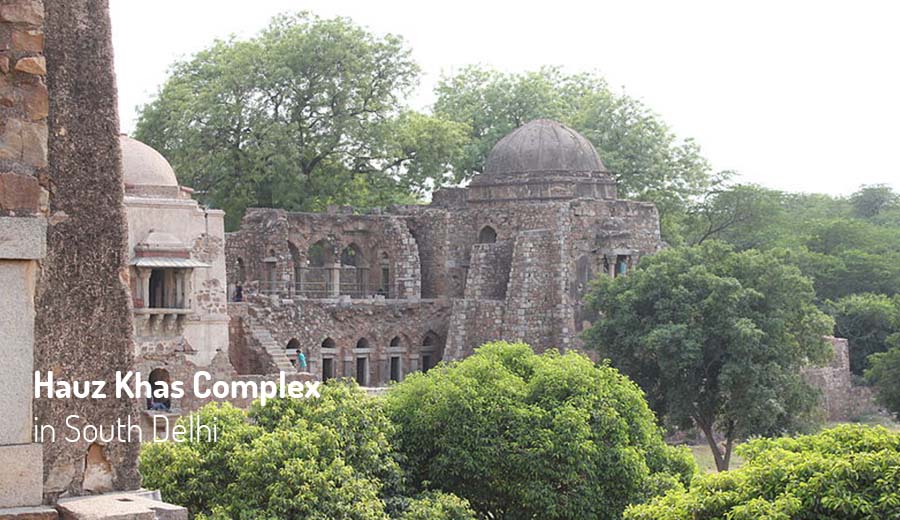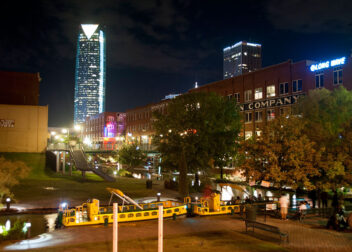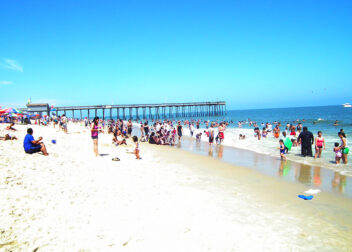Hauz Khas Complex
Located in the Southern part of Delhi, Hauz Khas is one of the ancient monuments of India. Hauz Khas Complex has been established in the year 1284 by Alauddin Khilji for supplying water to the Siri Fort. The name Hauz Khas means a special pond that has been built during medieval history. There are a number of monuments, madrasa, and mosque that overlooks the lake. The village is featured with domed tombs of the 15th and 16th centuries. The complex is now a great tourist spot surrounded by beautiful boutiques, art galleries, and restaurants.
History
The Hauz Khas Complex in South Delhi has a rich and fascinating history that spans several centuries. Here’s a brief overview:
- The lake: The Hauz Khas Lake was originally built in the 13th century as a reservoir to supply water to the nearby city of Siri. It was named after Alauddin Khilji, a ruler of the Delhi Sultanate, who ordered its construction.
- The palace and madrasa: During the reign of the Tughlaq dynasty in the 14th century, a palace and madrasa were built near the lake. The palace served as a residence for the Tughlaq rulers, while the madrasa was used as an Islamic school.
- The village: Over time, a village developed around the palace and madrasa, and the area became known as Hauz Khas Village. The village was a hub of cultural and artistic activity and was home to several Sufi saints and poets.
- Decline and preservation: After the fall of the Tughlaq dynasty, the Hauz Khas Complex fell into disrepair and was largely forgotten for centuries. In the 1980s, the government initiated a preservation project to restore the monuments and the lake. Today, the complex is a popular tourist destination and cultural hub.
The Hauz Khas Complex is a testament to the rich cultural heritage of Delhi, and offers a glimpse into the city’s past. A visit to the complex is an opportunity to immerse yourself in history and explore the fascinating architecture and monuments of one of India’s most historic cities.
Legend behind
In the beginning, the water tank was built to fulfill the needs of the Siri Fort in the second city of Delhi. Gradually it was modified by Feroz Shah of the Tughlaq dynasty. He cleared the clogged channels of the tank and re-excavated the silts that blocked it. The dimensions of the tank are 600*700*4 (width*length*depth). Previously the storage capacity of the tank was 0.8 Mcum but presently the capacity is reduced due to certain factors such as siltation and encroachment. During the rule of Feroz Shah, the city was known as Ferozabad. He was a great ruler and was known for achieving mastery over the arts and innovative ideas. Thus he used his innovative skills in designing monuments with his unique architectural styles. He renovated certain old monuments like the famous Qutub Minar, Suraj Kund, Ashokan pillars, and Sultan Ghari. He also raised various tombs and monuments along the banks of the water tank.
The present condition of the lake
As the royal water tank grew old, the inlets of the reservoir got blocked and the lake went dry. In the year 2004, a new plan was developed according to which rainwater is stored at the ridge by the embankment and then it is diverted into the pond. There is also an outside source that has been used to feed the water of the tank. With the help of the Indian National Trust for Art and Culture Heritage, the Hauz Khas Lake has been again revived. Along with the tank, the pavement, and the jogging area, the surrounding park has all been renovated for the tourists to have a wonderful experience in a clean environment. Presently it is the best place to visit in the city of Delhi. The Braj Foundation has been given the authority for maintaining the lake by the Delhi Development Authority. Recently, the Evolve Engineering group has put forward a proposal to the Delhi Development Authority to use the floating and constructed marshland for again bringing life to the royal tank.
Architectural structures
The main attraction of the complex is the tomb of Feroz Shah. Other structures present inside is the mosque, a madrasa (a theological college), and domed pavilions and all these were built in the 13th century. Before the rule of the Tughlaq dynasty, the pond was called Hauz-i-Khas. Later, Feroz Shah renovated it as the royal tank. After entering the complex, you can find a T-shaped pavilion surrounded by ruins. The unique feature of the complex is the stone railings that have formed a quad outside the entrance. Such railings are seen in Buddhist structures and are not familiar with Islamic buildings. However, the entire fort is a fantastic place to know the architectural design of the ancient period. It reflects the artistic mind of people of the medieval age and the culture of that period. Inside the complex, there are graves of Feroz Shah, his sons, and his grandson.
Useful information on Hauz Khas Complex
Entering the complex is absolutely free and it is open on all days of the week from 10 in the morning to 6 in the evening. There is a deer park at the entrance of the tank where you can find various animals such as peacocks, guinea pigs, varieties of birds and obviously spotted dears. In the evening, a show is performed by the Tourism Department narrating the history of the Hauz Khas Complex. The Indian Government Ministry of Tourism has set up a night bazaar at the village of Hauz Khas called ‘Eco Night Bazaar’ in order to provide food grains, handmade paper products, and seeds of unique plants that have been produced organically. Also, an open theatre and a place for watching cultural festivals have been proposed to be made at the place.
Reaching Hauz Khas Complex
The complex is accessible from all city centers by road and metro as well. The nearest metro stations are Hauz Khas and Green Park of Delhi Metro along the yellow line. ISTM is the nearest bus stop located near to the Hauz Khas Fort. Upon reaching there you can plan for other nearby attractions such as Kalkaji temple, Lotus temple, Hauz Khas Enclave, Chirag Dehlvi’s Dargah, and Nizamuddin’s shrine. There is a number of hotels to stay at nearby such as Haveli Hauz Khas and Hotel Park Residency.
There are certain environmental threats that the water lake is facing and due to this a case has been filed against the restaurants that are gradually spilling huge waste into the Hauz Khas Complex which is a threat to the natural vegetation of the region. So the National Green Tribunal of India has taken steps against it and asked them to promise such environmental protection otherwise their business could be in danger.
After you have completed visiting the nearby restaurants, shops, bars, and the village market, you need to visit the other part of the complex which is completely historical in nature. An old iron gate is the starting of this beautiful region. Through this gate, you would be transferred into a different world where there is a mosque, madrasa, tomb of Feroz Sah Tughlaq, and various monuments of the medieval era. And definitely, you would have the sight of the restored lake, the royal lake due to which the area got its identity. This is the place where you can make good use of your camera. Thanks to the Delhi Sultanate, Alauddin Khilzi who created such stunning monuments and a lake which proved to be such a wonderful destination for the tourist.
Things to do
If you’re visiting the Hauz Khas Complex in South Delhi, here are some of the things you can do:
- Visit the monuments: Explore the ruins of the Tughlaq dynasty palace and madrasa, and marvel at the intricate carvings and architectural details.
- Walk around the lake: Take a leisurely stroll around the Hauz Khas Lake, surrounded by lush greenery and birdlife.
- Browse the art galleries: Check out the contemporary art galleries in the complex, and see works by some of India’s most talented artists.
- Shop at the handicraft stalls: Shop for unique and handmade souvenirs at the handicraft stalls in the area.
- Explore the street art: Look out for the colorful murals and street art that adorn the walls in the Hauz Khas Village.
- Enjoy a meal or drink: Try the local cuisine at one of the many cafes, restaurants, or bars in the area, and soak up the lively atmosphere.
- Visit the Hauz Khas Village: Explore the narrow streets of the Hauz Khas Village, which is known for its vibrant nightlife and bohemian vibe.
- Attend cultural events: Check for any cultural events or festivals that may be taking place in the Hauz Khas Complex, and experience the rich cultural heritage of Delhi.
Tourist Attractions in Hauz Khas
The Hauz Khas Complex in South Delhi is home to a number of tourist attractions, including:
- Hauz Khas Lake: The centerpiece of the complex, the Hauz Khas Lake is a peaceful oasis surrounded by lush greenery. It’s a popular spot for picnics, evening walks, and birdwatching.
- Tughlaq dynasty monuments: The complex includes the remains of a palace and madrasa (Islamic school) built during the reign of the Tughlaq dynasty in the 14th century. These monuments are considered to be some of the finest examples of Islamic architecture in India.
- Contemporary art galleries: Hauz Khas is known for its vibrant arts scene, with numerous galleries and studios showcasing the works of contemporary Indian artists.
- Handicraft stalls: The area is also famous for its handicraft stalls, where you can find unique and handmade souvenirs.
- Street art: The walls of the Hauz Khas Village are adorned with colorful murals and street art, making for a lively and vibrant atmosphere.
- Cafes, restaurants, and bars: The complex is a popular hangout spot for young people and travelers, with a variety of dining and drinking options to choose from.
- Hauz Khas Village: The narrow streets of the Hauz Khas Village are known for their bohemian vibe and lively nightlife.
- Cultural events: The Hauz Khas Complex often hosts cultural events and festivals, giving visitors a chance to experience the rich cultural heritage of Delhi.
Timings and Entry Fee
The timings for visiting the Hauz Khas Complex in South Delhi vary depending on the attraction. Here are some of the common timings:
- Hauz Khas Lake: Open 24 hours, free entry
- Tughlaq dynasty monuments: Open from sunrise to sunset, INR 5 for Indian citizens, INR 100 for foreign nationals
- Art galleries: Timings vary, most are open from 11am to 7pm, free entry
- Handicraft stalls: Open from 11am to 7pm, free entry
- Street art: Open 24 hours, free entry
- Cafes, restaurants, and bars: Open from 11am to 11pm, prices vary
- Hauz Khas Village: Open 24 hours, free entry
Note: The entry fees and timings are subject to change and it’s best to check the official website or with local authorities for the most up-to-date information.
Essential information
Here is some essential information for visiting the Hauz Khas Complex in South Delhi:
- Location: The complex is located in the Hauz Khas neighborhood of South Delhi.
- Getting there: The best way to get to Hauz Khas is by taking a taxi or an Uber from anywhere in Delhi. You can also take the metro to the Hauz Khas station, which is located on the Yellow Line.
- Safety: The Hauz Khas Complex is generally safe, but it’s always advisable to be aware of your surroundings and take necessary precautions, especially when walking around at night.
- Clothing: Visitors should dress modestly, covering their shoulders and legs, when visiting religious sites or monuments.
- Photography: Photography is allowed in most areas of the complex, but it’s best to ask for permission before taking photos of people or inside galleries and shops.
- Food and drink: There are many cafes, restaurants, and bars in the complex, serving a variety of Indian and international cuisine. It’s also possible to buy street food and snacks from vendors in the area.
- Toilets: There are public restrooms located in the complex, but they may not always be well-maintained. It’s a good idea to carry a small packet of tissues and hand sanitizer.
- Local currency: The local currency in India is the Indian Rupee (INR). ATMs and money exchange facilities are readily available in the Hauz Khas area.
- Climate: Delhi has a tropical climate, with hot summers and cool winters. The best time to visit Hauz Khas is between October and March, when the weather is pleasant.



